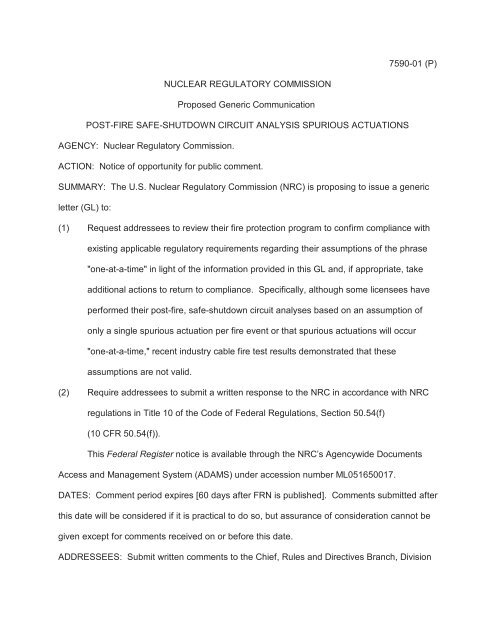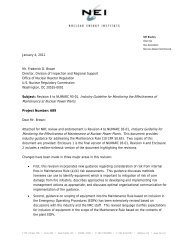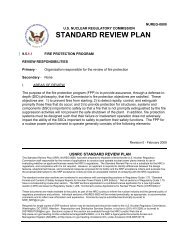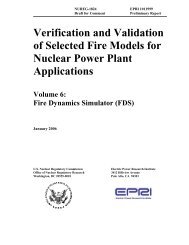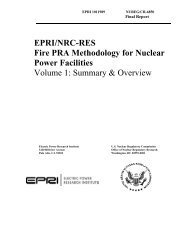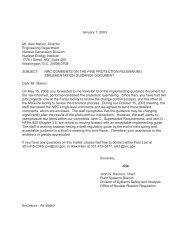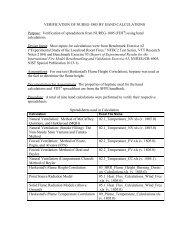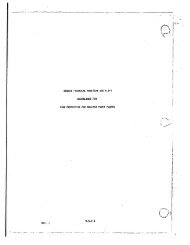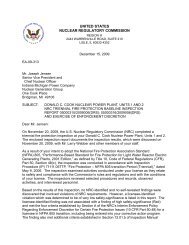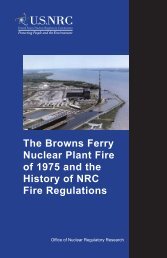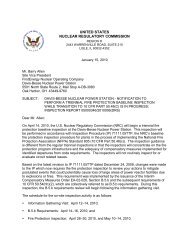NUCLEAR REGULATORY COMMISSION Proposed Generic ...
NUCLEAR REGULATORY COMMISSION Proposed Generic ...
NUCLEAR REGULATORY COMMISSION Proposed Generic ...
You also want an ePaper? Increase the reach of your titles
YUMPU automatically turns print PDFs into web optimized ePapers that Google loves.
Section III.G, "Fire Protection of Safe Shutdown Capability." All NPPs licensed to operate afterJanuary 1, 1979, were evaluated against Section 9.5.1 of NUREG-0800, Standard Review Plan(SRP). The fire protection plan (FPP) and the associated safety evaluation report (SER) arespecifically incorporated into those plants’ licensing bases. All NPP licensees are responsiblefor meeting fire protection commitments and license conditions made during the establishmentof their fire protection program.The objective of the fire protection requirements and guidance is to provide reasonableassurance that one train of systems necessary to achieve and maintain hot shutdown is free offire damage. This includes protecting circuits whose fire-induced failure could prevent theoperation, or cause maloperation, of equipment necessary to achieve and maintain post-firesafe shutdown. As part of its fire protection program, each licensee performs a circuit analysisto identify these circuits and to provide adequate protection against fire-induced failures.Beginning in 1997, the NRC staff noticed that a series of licensee event reports (LERs)identified plant-specific problems related to potential fire-induced electrical circuit failures thatcould prevent operation, or cause maloperation, of equipment necessary to achieve andmaintain hot shutdown. The staff documented these problems in Information Notice 99-17,"Problems Associated With Post-Fire Safe-Shutdown Circuit Analysis." Based on the numberof similar LERs, the NRC treated the issue generically. In 1998 the NRC staff started to interactwith interested stakeholders in an attempt to understand the problem and develop an effectiverisk-informed solution to the circuit analysis issue. NRC also issued Enforcement GuidanceMemorandum (EGM) 98-002, Rev. 2 (ADAMS Accession No. ML003710123), to provide aprocess for treating inspection findings while the issues were being clarified. Due to thenumber of different stakeholder interpretations of the regulations, the NRC decided totemporarily suspend the associated circuit part of fire protection inspections. This decision is- 4 -
demonstrated that neither interpretation conforms with the likely effects of a fire in an areacontaining safe-shutdown cables. Therefore, these interpretations do not ensure safeshutdown.In a S. J. Collins (NRC) letter to R. E. Beedle (NEI) dated March 11, 1997 (ADAMS AccessionNo. ML003716454), the NRC reiterated its position that multiple spurious actuations must beconsidered and evaluated. Subsequent to the Collins letter, the 2001 EPRI/NEI fire testingdemonstrated that multiple spurious actuations can occur with a relatively high likelihood andthat they can occur simultaneously or in rapid succession without sufficient time for mitigationbetween actuations.One of the key observations of the test report was that, "given that a hot short occurs in amulti-conductor cable, it is highly probable (over 80 percent) that multiple target conductors willbe affected (i.e., multiple simultaneous dependent hot shorts)." The testing covered most of thetypes of cable insulation and jacketing materials and types of raceways commonly used innuclear power plants. During the testing, numerous variables were introduced to investigatethe impact of various factors on cable performance and failure characteristics.While the staff has maintained that post-fire multiple spurious actuations should be considered,the number of actuations that must be considered has not been defined. Since thedeterministic approach to post-fire safe-shutdown analyses assumes that all cables in a firearea are damaged by the fire (except where protection is provided in accordance withSection III.G.2 of 10 CFR Part 50, Appendix R), it follows that all possible spurious actuations,as well as the cumulative effect of the actuations, should be considered.The SERs incorporated into the licensing bases of some plants (for example, Byron andBraidwood) specifically allow a design assumption of a single spurious actuation per fire eventwhen performing the post-fire safe-shutdown circuit analysis. However, most plants postulatedin their licensing basis that multiple spurious actuations occur one-at-a-time. All plants must- 6 -
eview their circuits analysis, assuming possible multiple spurious actuations occurringsimultaneously from a fire. Depending on the results of this review, licensees may concludethat they are no longer in compliance with the fire protection regulations. Those licensees whodetermine that they are no longer in compliance will either have to make plant modifications toprotect against possible multiple spurious actuations or request an exemption (or licenseamendment, as applicable) as described in the "METHODS OF COMPLIANCE" section of thisGL.An NEI letter dated May 30, 1997, presents the industry’s position on the phrase"one-at-a-time." The industry’s position is that "possible functional failure states from a singlehot short in the component’s control circuitry should be analyzed one-at-a-time (not sequentiallynor with cumulative consequences) for a fire in a certain fire area." As one basis for thisposition, the letter references the Response to Question 5.3.10 in GL 86-10, "Implementation ofFire Protection Requirements." Although this response states that "the safe shutdowncapability should not be adversely affected by any one spurious actuation or signal resultingfrom a fire in any plant area," per Question 5.3.10, the response applies only to Appendix R,Section III.L, "Alternative and Dedicated Shutdown Capability." The NRC emphasized thisposition in a letter from Dennis M. Crutchfield (Chief, Operating Reactors Branch #5, Division ofLicensing) to P. B. Fiedler (Vice President & Director - Oyster Creek) dated April 30, 1982(ADAMS Accession No. ML011150521) by stating that "it is essential to remember that thesealternative requirements (i.e., III.G.3 and III.L) are not deemed to be equivalent" to III.G.2protection.As noted in the attachment to a February 6, 1997, memorandum from L.B. Marsh (Chief, PlantSystems Branch, NRR) to J.F. Stolz (Director, Project Directorate I-2) regarding the NRC policyon the interpretation of NRC GL 86-10 guidance on spurious valve actuation, the reference to"any one spurious actuation" in the response to Question 5.3.10 is intended to provide a design- 7 -
asis for determining the capacity and capability of the alternative or dedicated shutdown train(e.g., size of the pump and the support systems needed to maintain reactor coolant inventory,the scope of onsite electrical power distribution and power needs, and an operational baselineand set of plant conditions to define the scope of initial manual actions to restore systemsnecessary to accomplish the required reactor performance goals). Again, these alternativerequirements do not provide the same level of protection as III.G.2.NEI also stated in the May 30, 1997, letter that "any other interpretation leads to complex andcostly analysis which is not justified for the very small safety benefit." The NEI letter offered noassessment of the safety significance of multiple sequential and cumulative failures. It isimportant to note that the NEI letter of May 30, 1997, preceded the 2001 EPRI/NEI fire testing,and that before the testing, the industry had long claimed that spurious actuations were notcredible. As noted above, the cable functionality fire testing demonstrated that multiplespurious actuations can occur and that they can occur in rapid succession without sufficienttime for mitigation. Therefore, if a licensee does not account for multiple spurious actuations intheir circuits analysis, they are not in compliance with 10 CFR 50.48 and 10 CFR Part 50,GDC 3, which require that a licensee is to provide reasonable assurance that one train ofsystems necessary to achieve and maintain hot shutdown is free of fire damage.METHODS OF COMPLIANCEBased on the information provided in this GL, if a licensee concludes that they are no longer incompliance with the fire protection regulations, there are several acceptable methods for themto re-establish full regulatory compliance. One way is to re-perform the post-fire safe-shutdowncircuit analysis based on guidance provided in this GL and make modifications necessary tocome into compliance. Another method to address this issue is to perform either arisk-informed evaluation that considers defense-in-depth and safety margins or a deterministic- 8 -
evaluation:• If a licensee proposes to use a risk-informed approach to justify an exemption inaccordance with 10 CFR 50.12, then this approach should follow the guidance ofRG 1.174, "An Approach for Using Probabilistic Risk Assessment in Risk-InformedDecisions on Plant-Specific Changes to the Licensing Basis."• For those licensees who have adopted the standard fire protection license condition aspromulgated in GL 86-10, changes to the approved fire protection program can be madewithout prior staff approval if those changes would not adversely affect the ability toachieve and maintain safe shutdown in the event of a fire. GL 86-10, "Implementationof Fire Protection Requirements," provides guidance on performing and documentingthese changes. Plants licensed after January 1, 1979, that use a risk-informedapproach must submit a license amendment in accordance with 10 CFR 50.90. Theexception to 10 CFR 50.90, provided in the standard license condition and in 10 CFR50.48(f)(3), does not apply because the risk assessment approaches used by plantsdeviate from the approved deterministic approaches used in their licensing basis.Furthermore, the licensees’ risk assessment tools have not been reviewed or inspectedagainst quality standards found acceptable to the NRC staff. Consequently, the staffbelieves that the use of risk informed approaches without prior NRC approval may resultin changes that could adversely affect safe shutdown.Fire modeling and risk techniques acceptable to the staff should be used when performingrisk-informed evaluations.An additional method to achieve compliance is the adoption of a performance-based fireprotection program in accordance with 10 CFR 50.48(c), "National Fire Protection AssociationStandard NFPA 805." The Draft Regulatory Guide DG-1139, "Risk-Informed,Performance-Based Fire Protection for Existing Light-Water Nuclear Power Plants," dated- 9 -
September 2004 (ADAMS Accession No. ML042740308) and NEI 04-02, "Guidance forImplementing a Risk-Informed, Performance-Based Fire Protection Program Under10 CFR 50.48(c)," Rev. 0, dated May 2005 (ADAMS Accession No. ML051440805), provideadditional guidance to licensees who plan to use this option.APPLICABLE <strong>REGULATORY</strong> REQUIREMENTSNRC regulations in 10 CFR 50.48 and 10 CFR Part 50, Appendix A, GDC 3, require eachoperating NPP (licensed before or after issuance of GDC 3) to have a FPP providing post-firesafe shutdown capability. That is, a means must be provided of ensuring that one of theredundant trains of safe shutdown structures, systems, and components must be protected sothat it remains free of fire damage, allowing safe shutdown of the plant. The regulation in10 CFR 50.90 requires a licensee who desires to amend their license, to submit an amendmentrequest to the NRC. A NPP licensed to operate before January 1, 1979, may submit anexemption request in accordance with 10 CFR 50.12.All NPPs licensed to operate before January 1, 1979 (pre-1979 plants), are required to complywith 10 CFR Part 50, Appendix R, paragraph III.G, "Fire Protection of Safe ShutdownCapability." Paragraph III.G states, in part, that "one train of systems necessary to achieve andmaintain hot shutdown conditions from either the control room or emergency control station(s)is free of fire damage." Paragraph III.G.2 states, in part, "where cables or equipment, includingassociated non-safety circuits that could prevent operation or cause maloperation due to hotshorts, open circuits, or shorts to ground, of redundant trains of systems necessary to achieveand maintain hot shutdown conditions are located within the same fire area outside of primarycontainment, one of the following means of ensuring that one of the redundant trains is free offire damage shall be provided:" All NPPs licensed to operate after January 1, 1979, arerequired to comply with 10 CFR 50.48(a), which requires that each operating NPP have a FPP- 10 -
that satisfies GDC 3. The FPP is incorporated into the operating license for post-1979 plantsas a license condition. This license condition specifically cites the staff SER in the licensee’sFPP, to demonstrate that the license condition has been met (although licensees may modifytheir FPP as long as there is no adverse effect on safe shutdown).Based on the new information provided by the EPRI/NEI cable fire tests, approved fireprotection programs that do not include protection against possible multiple spurious actuationsoccurring simultaneously (including programs for plants with SERs that specifically approve anassumption of one-only spurious actuation per fire event) may not comply with these regulatoryrequirements.APPLICABLE <strong>REGULATORY</strong> GUIDANCEFire-induced hot shorts that cause spurious actuations can prevent a train from performing itspost-fire safe-shutdown function. NRC regulations, while noting that spurious actuations mustbe considered, do not set a limit on the number of spurious actuations that can occur. Inaddition, NRC regulations do not state whether multiple spurious actuations should be assumedto occur simultaneously or sequentially. Any limits or assumptions used by the licensee inperforming the post-fire safe-shutdown circuit analysis should be adequately justified.In order to demonstrate compliance with the regulatory requirement that one safe shutdowntrain remain free of fire damage, licensees must address the potential for multiple, concurrentspurious actuations by analyzing for these failures and providing adequate protection whererequired.Fire modeling techniques and risk analysis techniques which the staff has found acceptable areprovided in Section 4.0 of Draft Regulatory Guide DG-1139, "Risk-Informed,Performance-Based Fire Protection for Existing Light-Water Nuclear Power Plants," datedSeptember 2004 (ADAMS Accession No. ML042740308) and may be used in the evaluations.- 11 -
The deterministic methodology in NEI 00-01, Rev. 1 (January 2005), "Guidance for Post-FireSafe Shutdown Circuit Analysis," Chapter 3, for analysis of post-fire safe-shutdown circuits, inconjunction with the guidance provided in this GL, is one acceptable approach to achievingregulatory compliance with post-fire safe-shutdown circuit protection requirements for multiplespurious actuations. Licensees should assume that the fire may affect all unprotected cablesand equipment within the fire area and address all cable and equipment impacts affecting therequired safe shutdown path in the fire area. All potential impacts within the fire area must beaddressed.The risk significance analysis methodology provided in Chapter 4 of NEI 00-01 should not beapplied as a basis for regulatory compliance, except where a National Fire ProtectionAssociation (NFPA) 805 licensing basis has been adopted in accordance with 10 CFR 50.48(c).Risk-informed or performance-based methodologies that use the methods and informationprovided in NEI 00-01 (e.g., Chapter 4 and Appendix B-1) may be used to support exemptionrequests for plants that have not adopted an NFPA licensing basis. Furthermore, regardless ofthe plant licensing basis, the NRC agrees with the NEI 00-01 guidance that "all failures deemedto be risk significant, whether they are clearly compliance issues or not, should be placed in theCorrective Action Program with an appropriate priority for action." The remaining sections ofNEI 00-01 provide acceptable circuit analysis guidance on both the deterministic approach andthe risk-informed, performance-based approach.REQUESTED ACTIONSWithin 90 days of the date of this letter, all addressees are requested to take the followingactions:- 12 -
(1) Assess plant post-fire safe-shutdown circuit analyses for regulatory compliance inaccordance with the information contained in this GL. The NRC informed licensees ofthese compliance expectations in a public meeting in October 2004 (ADAMS AccessionNo. ML043290020).(2) Take appropriate compensatory measures in accordance with plant fire protectionprograms if the addressees’ interpretation and use of multiple spurious actuations intheir circuits analysis leads to the conclusion that the addressee is no longer incompliance with the fire protection regulations.(3) Submit licensee’s plans for plant modifications, license amendments or exemptionrequests that the above evaluation identifies as necessary to re-establish compliancewith regulatory requirements and the plant’s licensing basis in accordance with theinformation contained in this GL.REQUESTED INFORMATIONAll addressees are requested to provide the following information:(1) Within 90 days of the date of this GL, provide a statement on whether or not youconclude you are in compliance with the regulatory requirements as described in theApplicable Regulatory Requirements section of this GL. Addressees who conclude thatthey continue to be in compliance with the regulatory requirements in light of theinformation provided in this GL should state the basis for their conclusion.(2) Addressees who conclude that they are not in compliance with the regulatoryrequirements as described in the Applicable Regulatory Requirements section of thisGL, provide the following information:a. An assessment of the functionality of affected structures, systems, andcomponents that addresses the ability to achieve and maintain safe shutdown in- 13 -
light of multiple spurious hot shorts as a result of a fire. An acceptableassessment would be consistent with an evaluation performed for GL 91-18,Rev. 1.b. A detailed description of the compensatory measures in place to maintain thesafe shutdown function of affected areas of the plant, and an explanation of howthe compensatory measures provide adequate protection.c. A general description and planned schedule for any plant modifications made toensure compliance with the regulatory requirements listed in the ApplicableRegulatory Requirements section of this GL.d. A general description and planned schedule for any changes to the plantlicensing bases resulting from any evaluation performed to ensure compliancewith the regulatory requirements listed in the Applicable RegulatoryRequirements section of this GL. Include a discussion and schedule for anylicense amendment or exemption requests needed to support changes to theplant licensing basis.e. Where the licensee plans no action under (a) or (b) or (c) or (d), provide ajustification for not assessing safety significance or taking compensatory andcorrective actions.REQUIRED RESPONSEIn accordance with 10 CFR 50.54(f), in order to determine whether a facility license should bemodified, suspended, or revoked, or whether other action should be taken, an addressee isrequired to respond as described below.Within 30 days of the date of this GL, an addressee is required to submit a written response if itis unable to provide the information or it cannot meet the requested completion date. The- 14 -
addressee must address in its response any alternative course of action that it proposes totake, including the basis for the acceptability of the proposed alternative course of action.The required written responses should be addressed to the U.S. Nuclear RegulatoryCommission, ATTN: Document Control Desk, 11555 Rockville Pike, Rockville, Maryland20852, under oath or affirmation under the provisions of Section 182a of the Atomic Energy Actof 1954, as amended, and 10 CFR 50.54(f). In addition, submit a copy of the response to theappropriate regional administrator.REASON FOR INFORMATION REQUESTAs discussed above, EPRI/NEI-performed cable fire testing in 2001 demonstrated that multiplespurious actuations can occur with relatively high likelihood and that they can occursimultaneously or in rapid succession without sufficient time for mitigation between actuations.However, many licensees’ circuits analysis and/or safe-shutdown analysis did not consider thisrelatively high probability.The NRC staff will review the responses to this GL and will notify affected addressees ifconcerns are identified regarding compliance with NRC regulations. The staff may alsoconduct inspections to determine addressees’ effectiveness in addressing the GL.RELATED GENERIC COMMUNICATIONSGL 86-10, "Implementation of Fire Protection Requirements," April 24, 1986GL 91-18 Rev. 1, "Information to Licensees Regarding NRC Inspection Manual Section onResolution of Degraded and Nonconforming Conditions," October 8, 1997Information Notice (IN) 92-18, "Potential for Loss of Remote Shutdown Capability During aControl Room Fire," February 28, 1992RIS 2004-03, "Risk-Informed Approach for Post-Fire Safe-Shutdown Associated CircuitInspections," March 2, 2004- 15 -
RIS 2004-03 Rev. 1, "Risk-Informed Approach for Post-Fire Safe Shutdown CircuitInspections," December 29, 2004RIS 2005-XXX, "Clarification of Post-Fire Safe-Shutdown Circuit Regulatory Requirements"(Draft issued for public comment on May 13, 2005)BACKFIT DISCUSSIONUnder the provisions of Section 182a of the Atomic Energy Act of 1954, as amended,10 CFR 50.109(a)(4)(I), and 10 CFR 50.54(f), this GL requests addressees to evaluate theirfacilities to confirm compliance with the existing applicable regulatory requirements asdiscussed in this GL.The fundamental regulatory requirement is that at least one safe-shutdown path be maintainedfree of fire damage in the event of fire. The NRC’s position concerning this regulatoryrequirement has not changed. All NPPs licensed to operate before January 1, 1979,(pre-1979 plants) are required to comply with 10 CFR Part 50, Appendix R, paragraph III.G,"Fire Protection of Safe Shutdown Capability," including Paragraph III.G.2. Paragraph III.Gstates, in part, that "one train of systems necessary to achieve and maintain hot shutdownconditions from either the control room or emergency control station(s) is free of fire damage."Paragraph III.G.2 states, in part, "where cables or equipment, including associated non-safetycircuits that could prevent operation or cause maloperation due to hot shorts, open circuits, orshorts to ground, of redundant trains of systems necessary to achieve and maintain hotshutdown conditions are located within the same fire area outside of primary containment, oneof the following means of ensuring that one of the redundant trains is free of fire damage shallbe provided:"All NPPs licensed to operate after January 1, 1979, are required to comply with10 CFR 50.48(a), which requires that each operating nuclear power plant have a FPP that- 16 -
satisfies GDC 3. The fire protection plan is incorporated into the operating license forpost-1979 plant as a license condition. This license condition specifically cites the staff SER onthe licensee’s FPP, to demonstrate that the license condition has been met (although licenseesmay modify their FPP as long as there is no adverse effect on safe shutdown). All NPPlicensees are required to implement their approved fire protection program, considering multiplespurious actuations, in accordance with the applicable regulatory requirements.Fire-induced hot shorts that cause spurious actuations can prevent a train from performing itspost-fire safe shutdown function. The regulations note that spurious actuations must beconsidered.Prior to the EPRI/NEI cable fire tests in 2001, very little data was available to provide a basis forpredicting the extent or behavior of spurious actuations during a fire. Based on the availabledata and expert opinion, the industry assumed and, in some specific cases, the NRC acceptedthat spurious actuations that could prevent safe shutdown were highly improbable.Consequently, some licensees assumed only a single spurious actuation per fire event. Othersassumed multiple spurious actuations, but assumed that they would only occur "one-at-a-time"with time between actuations to take corrective actions. These assumptions were neverincluded in the regulations or generally adopted by the NRC.The 2001 EPRI/NEI fire test program demonstrated that the previous assumptions regardingspurious actuations do not adequately address the potential risk to safe shutdown. TheEPRI/NEI cable fire tests clearly showed, during and after a fire, a relatively high probability thatmultiple spurious actuations will occur simultaneously or in rapid succession. Consequently, todemonstrate compliance with the regulatory requirement that one safe shutdown train remainfree of fire damage (which has always been the NRC’s position), and with licensees’ licensingbases, licensees must address the potential for multiple concurrent spurious actuations byanalyzing these failures and providing adequate protection where required.- 17 -
The information requested by this GL is therefore considered a compliance exception to therule in accordance with 10 CFR 50.109(a)(4)(I), as the staff’s position set out in this GLregarding the term "one-at-a-time" is necessary for compliance with 10 CFR 50, Appendix R,Paragraph III.G (with respect to pre-1979 plants) and, with respect to post-1979 plants, isnecessary for compliance with the plants’ license conditions regarding fire protection.With regard to plants for which the NRC had in the past specifically accepted the assumptionthat only a single spurious actuation would occur per fire event, or that multiple spuriousactuations would occur "one-at-a-time" with time between actuations to take corrective actions,this GL is considered a compliance exception to the backfit rule, in accordance with10 CFR 50.109(a)(4)(I). New information from the 2001 EPRI/NEI cable fire tests has shownthat multiple, simultaneous spurious actuations must be considered for these licensees to be incompliance with NRC’s unchanged interpretation of its fire protection requirements, whichrequire that one safe shutdown train remain free of fire damage.FEDERAL REGISTER NOTIFICATIONA notice of opportunity for public comment on this GL was published in the Federal Register(XX FR XXXXX) on October XX, 2005.SMALL BUSINESS <strong>REGULATORY</strong> ENFORCEMENT FAIRNESS ACTThe NRC has determined that this action is not subject to the Small Business RegulatoryEnforcement Fairness Act of 1996.PAPERWORK REDUCTION ACT STATEMENTThis GL contains information collections that are subject to the Paperwork Reduction Act of1995 (44 U.S.C. 3501 et seq.). These information collections were approved by the Office ofManagement and Budget (OMB), clearance number 3150-0011, which expires onFebruary 28, 2007.- 18 -
The burden to the public for these mandatory information collections is estimated to average300 hours per response, including the time for reviewing instructions, searching existing datasources, gathering and maintaining the data needed, and completing and reviewing theinformation collection. The U. S. Nuclear Regulatory Commission is seeking public commenton the potential impact of the information collections contained in the GL and on the followingissues:1. Is the proposed information collection necessary for the proper performance of thefunctions of the NRC, including whether the information will have practical utility?2. Is the estimate of burden accurate?3. Is there a way to enhance the quality, utility, and clarity of the information collected?4. How can the burden of the information collection be minimized, including the use ofautomated collection techniques?Send comments on any aspect of these information collections, including suggestions forreducing the burden, to the Records and FOIA/Privacy Services Branch (T5-F52), U.S. NuclearRegulatory Commission, Washington, DC 20555-0001, or by Internet electronic mail toBJS1@NRC.GOV; INFOCOLLECTS@NRC.GOV; and to the Desk Officer, Office ofInformation and Regulatory Affairs, NEOB-10202 (3150-0011), Office of Management andBudget, Washington, DC 20503.Public Protection NoticeThe NRC may not conduct nor sponsor, and a person is not required to respond to, aninformation collection unless the requesting document displays a currently valid OMB controlnumber.- 19 -
CONTACTPlease direct any questions about this matter to the technical contact or the Lead ProjectManager listed below, or to the appropriate Office of Nuclear Reactor Regulation (NRR) projectmanager.Bruce A. Boger, DirectorDivision of Inspection Program ManagementOffice of Nuclear Reactor RegulationTechnical Contact:Robert Wolfgang, NRR301-415-1624E-mail: rjw1@nrc.govLead Project Manager:Chandu Patel, NRR301-415-3025E-mail: cpp@nrc.govNote: NRC generic communications may be found on the NRC public Web site,http://www.nrc.gov under Electronic Reading Room/Document Collections.END OF DRAFT GENERIC LETTERDocuments may be examined, and/or copied for a fee, at the NRC’s Public Document Room atOne White Flint North, 11555 Rockville Pike (first floor), Rockville, Maryland. Publicly availablerecords will be accessible electronically from the Agencywide Documents Access andManagement System (ADAMS) Public Electronic Reading Room on the Internet at the NRCWeb site, http://www.nrc.gov/NRC/ADAMS/index.html. If you do not have access to ADAMS or- 20 -
if you have problems in accessing the documents in ADAMS, contact the NRC PublicDocument Room (PDR) reference staff at 1-800-397-4209 or 301-415-4737 or by e-mail topdr@nrc.gov.Dated at Rockville, Maryland, this 13 th day of October 2005.FOR THE <strong>NUCLEAR</strong> <strong>REGULATORY</strong> <strong>COMMISSION</strong>/RA/Michael J. Case, Deputy DirectorDivision of Inspection Program ManagementOffice of Nuclear Reactor Regulation- 21 -
if you have problems in accessing the documents in ADAMS, contact the NRC PublicDocument Room (PDR) reference staff at 1-800-397-4209 or 301-415-4737 or by e-mail topdr@nrc.gov.Dated at Rockville, Maryland, this 13 th day of October 2005.FOR THE <strong>NUCLEAR</strong> <strong>REGULATORY</strong> <strong>COMMISSION</strong>/RA/Michael J. Case, Deputy DirectorDivision of Inspection Program ManagementOffice of Nuclear Reactor RegulationDISTRIBUTION:IROB R/F A. Markley R. Wolfgang, DSSA M. Ross-LeeD. Frumkin S. Weerakkody C. PatelADAMS ACCESSION NUMBER: ML052780098OFFICE OES:IROB:DIPM DSSA A:SC:OES:IROB:DIPM IROB/DIPM DIPM/NRRNAME AWMarkley RWolfgang MJRoss-Lee PHiland MCaseDATE 10/4/2005 10/5/2005 10/11/2005 10/11/05 10/13/05OFFICIAL RECORD COPY- 21 -


